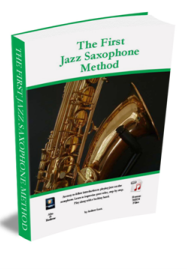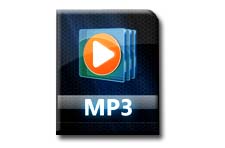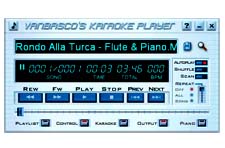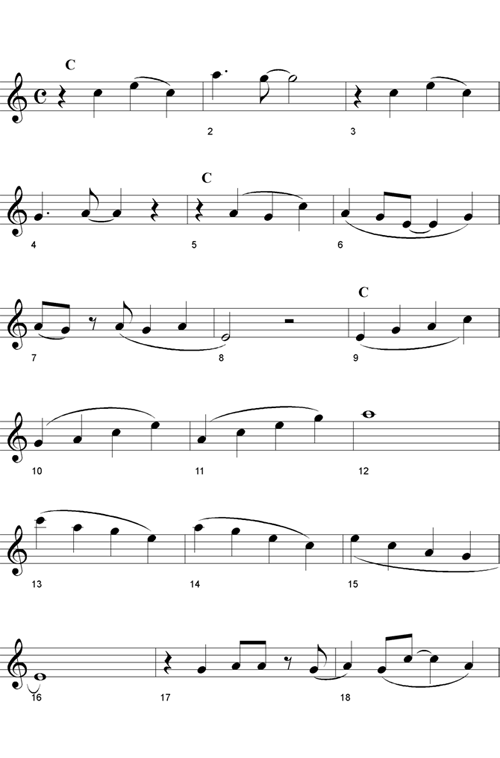Learn the Art of Playing Great JazzSaxophone Solos – Every Time |
||
Sign up for my 5 Free Jazz Saxophone Lessons via EmailEach day for 5 days, I will send you a page or two from
“The First Jazz Saxophone Method”
|
||
 How Good Could It Be? How Good Could It Be?
You’re in the zone. In tune, blowing a solo over one of your favorite tunes. The rhythm’s right, the feel is good. You have a great reed that responds to your every command. Each phrase forms in the air precisely as you imagined it a few milliseconds before. You know with absolute certainty how your phrase is going to sound before you play it. You’ve let go of words and you’re thinking in pure musical ideas. Your audience is with you, hanging spellbound on your every note. It’s a feeling of great power and creativity. This is the art of improvisation. My Story I don’t always experience “the zone” when I’m playing, but at least I know how to get there, most of the time. It wasn’t always like that for me. When I first began blowing solos I pretty much relied solely on my ear to tell me what was good and what was bad. I thought improvisation was an endless experiment that sometimes turned out, and sometimes not. If one was a genius, as I believed myself to be, all that was necessary was to practise often enough and for long enough, and surely and steadily my inner muse would blossom and bear fruit, in the form of endless streams of impeccably constructed phrases, each cleverer and more beautiful than the last. Sadly, it was not to be. I often endured hurtful comments by people who happened to be present at my self-indulgent performances. Some of the worst were:
I bought several of Jamey Aebersold’s books – great stuff if you have a little knowledge already, and know what you are doing. I read such highbrow works as, “New concepts in Linear Improvisation”, which left me more confused than before I started. I read and practised through every textbook on improvisation I could afford to buy or borrow. I read and listened to interviews with the masters, the icons of the jazz world, the gurus of swing. I analyzed and copied their solos note for note. But still I was missing the vital link – the step-by-step progression from the first note. I wanted to find a way to combine the science of improvisation, as there seemed to be one, with my personal creativity. How could I start with one note and turn it into many in my own, unique style. Famous players seemed to know how to do this, but I couldn’t find anyone to teach me, nor any written course. Then one day I signed up for some piano lessons with a veteran of piano performance and teaching, a legendary unknown named Frank Buller. During a lesson I told him that I was trying to learn how to play solos. Frank knew exactly what I was looking for. He taught me this method that I am now able to pass on to you. So what do I sound like now? Here’s a track I recorded in 2002, playing tenor sax. My friend Garry Stocks is playing electric guitar. The tune is All of Me.
I’m no Stan Getz, but I’m proud of this track, and I’d like to share with you the method I used to create it. Your Solo Your solo is your chance to shine. The solo is where you can break free from boundaries, represented by written or memorized notes. You will create your own melody on the spot, instantly, spontaneously. This is why jazz can be so exciting – there is something new about every performance. We start with one note from one chord. If you sign up for my free, introductory 5 lesson course, you’ll learn that this first note is C, played in any register, any way you feel, against a backdrop of a rhythm section vamping on a C chord. Then, having mastered Step One, we’re on our way. We learn the second note from the C chord – E. We play around with that for a while, then add our next note – G. And so it goes. We keep adding notes to our toolbox one at a time, learning how to use them as we go. Because notes ain’t notes. Some of them sound good in certain spots, others don’t. If the rhythm section is giving us the F chord, we can’t just blast away at F, the way we do with C, and expect it to sound as good. There’s a simple technique to using F, that you’ll learn when you buy the full version of my Method. Improvisation This 64-page ebook will teach you the letter “A” of improvising. It will show you how to produce tasteful saxophone solos that sound different every time. Although you’ll still have a lot to learn at the end of the book, you will have learnt how to begin improvising, and well begun is half done. Start from the Beginning Although you need some ability on the saxophone, you don’t need to know much about scales, chords or music theory. The Method begins by showing you how to build a solo with just 3 C notes, while the backing band on the recording plays around with a C chord. You will then be shown, step-by-step, how to add other notes, to your solos, one at a time. Each step along the way is very musical and tasteful. You will need to know the basics of playing the saxophone, such as elementary reading of music and the fingering for most of the notes. If you need to refresh your memory, refer to the fingering index at the back of The Art of Saxophone. No Wrong Notes! When you follow the instructions from the first lesson you won’t be able to play a note that sounds bad. Starting with only the note C, you’ll learn how to play a solo where all the notes harmonize perfectly with the rhythm section. Swing & Latin There are basically two types of beat that a rhythm section plays. The first is called Swing, and the second is Latin. You will be shown how to tell the difference between them, and how to solo accordingly, to match your playing to the rhythm section. 14 Solos to Copy and Learn Although this book is about you learning to play your own solos, it’s useful when we begin studying an art to copy others. To give you ideas for creating your own solos, there are 14 saxophone solos recorded and written out for you to play. Some of the solos have commentaries, so you can see how the solo was constructed. You will be able to play what you hear on the recording by simply reading the transcription. Here’s an example of one of the solos: Solo with the 6th You’ll Learn Faster if You Know How it Should Sound 40 Backing Tracks Everyone I’ve taught and spoken to about learning music confirms that it’s easier to play songs that they’ve heard before and already know. To make your progress as fast as possible, there are 40 MP3 recordings of the songs and exercises in the book. These backing tracks that accompany this ebook give you the chance to practise your solos as many times as you like. By playing them over and over you will:
Like a faithful dog, the tracks never become bored listening to you. The backing band plays each exercise twice – once with a saxophone to demonstrate the solo, then a 2nd time without the saxophone for you to play your own solo. Tempos are slow, but lively, so you’ll find it easy to keep up and still tap your foot. Training Wheels Off The final icing on the cake is a 2-chord song that lets you apply your newfound knowledge to a familiar theme. The melody is written out for you, followed by a suggested solo for you to learn, copy, analyze and improve upon. A helpful commentary gives pointers on how the solo was constructed. Need More? Also among the audio files are 6 extra tracks containing extended recordings of various chord backings in several styles. You’ll be able to study each chord in depth to train your ear to hear what’s in your mind before you play it. This is an ability possessed by the finest jazz musicians. Jam with Others Perhaps you know someone who can play keyboard or guitar. This Method contains chord symbols above every song and exercise, so a guitarist or keyboard player can jam with you. You can even make up your own band with any or all of the following instruments: MP3 player, keyboard, guitar, one or more other saxophone players. What Other People Think I’ve been selling this Method on Ebay for a few years. Here are a few of the feedbacks from buyers:
|
New to the Saxophone?
Option B takes you right from the start, up to the point where you only need a little more technique to begin blowing your solos.
| Option B: Silver Digital Edition | |||||
 |
The Art of Saxophone, Immediate Download in PDF form………………….. |
$20 | |||
 |
+ MP3 Audio Backing Tracks………………………… | $ 10 | |||
| + MIDI files ……………………………………………… | $10 | ||||
 |
+ MIDI file player………………………………………. | $ 10 | |||
 |
+ Jazz Saxophone Method, Immediate Download in PDF form……………… |
$ 20 | |||
 |
+ MP3 Audio Backing Tracks for Jazz Saxophone Immediate Download……….. |
$ 10 | |||
| Total Value…………………………………………………………….. | $80 | ||||
| Discounted Sales Price………………………………………… | $40 | ||||
|
|||||
 I’m so confident that you’ll find my jazz Saxophone Method good I’m offering you a 30-day money back guarantee. If you don’t think it’s helpful, simply email me and I’ll refund your money in full.
I’m so confident that you’ll find my jazz Saxophone Method good I’m offering you a 30-day money back guarantee. If you don’t think it’s helpful, simply email me and I’ll refund your money in full.
I hope you enjoy learning from this book and recording package.
You, and the world, will benefit from the music that is within you.
![]()
P.S. The greatest Saxophone solo ever begins with your first note. Why put it off another day?



